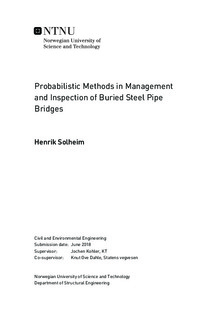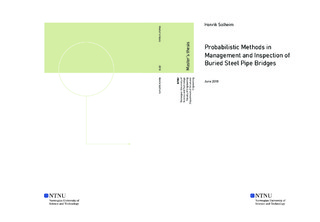| dc.description.abstract | Management and inspection of existing bridges involve decision making. Loading, resistance and deterioration of bridges are uncertain. Inspection reduces uncertainty, but the uncertainty is usually not considered on a theoretical basis. There is, however, well-established probabilistic theory to handle uncertainties. Using a structured probabilistic approach might optimise decisions by weighing cost towards benefit.
Norwegian Public Roads Administration manages more than 17,500 national and county bridges in Norway. They have their own practise and guidelines for inspection of bridges. The focus in this study is directed towards buried corrugated steel pipe bridges. A corrugated steel pipe bridge is regarded a flexible pipe, as the surrounding soil is stiffer than the wall of the pipe. Both the steel pipe and the surrounding soil contribute to the bearing capacity.
Bayesian decision analyses are used to guide a consistent decision-making process. The benefit from risk reduction is considered in these analyses. Different measurements and actions are analysed. Bayesian theory is also used to get a better understanding of the condition of the pipe bridges. Bayesian networks illustrate the variables of the structural system graphically, and this is quite useful for complex structural systems as the buried steel pipe bridges.
Structural reliability analyses can also assess the condition of the pipe bridges. First order reliability analysis is used to calculate the probability of yield of the pipe bridge steel wall. With a simple example, it is shown that a Bayesian network might connect the probability of yield with the probability of complete structural failure.
Estimation of deterioration is important for management of bridges, and strategies and budgeting can be made upon deterioration predictions. A statistical approach considers observations of damage development for 157 buried pipe bridges. The damage observations are divided into four degrees. A continuous-time Markov process is used to predict the deterioration. The model is fitted to observations with a maximum likelihood estimation. A prediction of deterioration is also made for a selection of bridges based on the climate at their location. The deterioration dependent on climate is modelled in a dynamic Bayesian network.
Failure prediction is also relevant for decision making. Five of the 157 bridges have failed. A sequential Markov process is used to predict failures for this bridge stock. Five new failures are estimated to occur within the next six years if nothing is done and all the bridges continue to deteriorate. A dynamic Bayesian network can consider a higher complexity prediction which is also dependent on variables. This makes it suitable for predicting failure of an individual bridge and predicting failures in the whole bridge stock.
Replacement strategies are studied for the bridge stock and individual bridges. Since several of the bridges are in a very bad condition, replacement has been a preferred action. Replacement strategies are assessed by modifying the deterioration prediction. Improving the bridge stock condition seems to be beneficial as it reduces risk. The risk is high with the current condition of the bridge stock. Replacement analysis of individual bridges can indicate when the bridges should be replaced and which bridges to prioritise. | |

